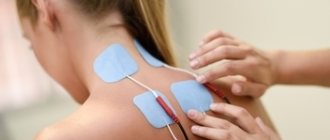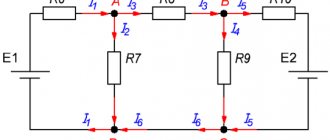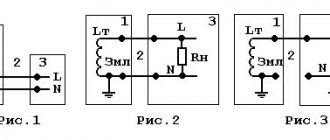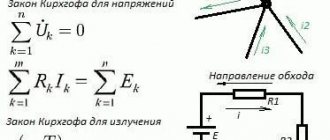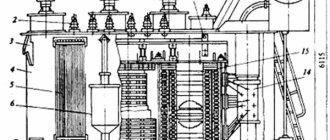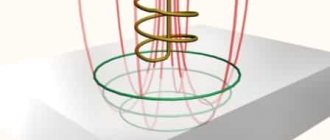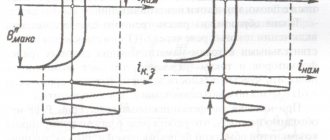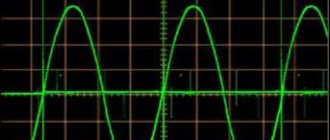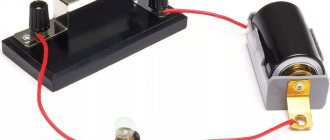Electrotherapy is the use of the properties of electric current for therapeutic purposes; it occupies a separate large section in physiotherapy. Modern methods of physiotherapy use electric current to combat various pathologies: injuries of the musculoskeletal system, diseases of the nervous system, during recovery in the postoperative period.
This article will discuss the various uses of electrotherapy in medicine, and also describe the main mechanism of its action on the human body.
Mechanism of action
To understand why electric current has become so widely used in medical practice, you need to understand the subtle mechanisms and principles of its influence on the body.
It affects the human body on several levels:
- Local. Covers the immediate area of application of electric current. Local blood circulation is stimulated, immunity is increased, and metabolism is accelerated.
- Reflex-segmental. Electric current during the procedure causes somatovegetative reflexes, which cause vascular and metabolic changes already at the level of internal organs (after all, as is known, internal organs have connections with certain areas of the skin, influencing which can indirectly influence the organs).
- Organismic level. The effect of electrical procedures on the body extends to the higher parts of the nervous system, then the release of biologically active substances (serotonin, histamine, norepinephrine, acetylcholine) occurs, which, carried through the bloodstream, provide the general effect of physiotherapy - strengthening the immune system, mobilizing the body's strength, accelerating recovery processes and regeneration.
According to the nature of the energy conducted to the patient, electrotherapy methods are divided into remote and contact, according to the voltage - into low-frequency currents (galvanization, electrophoresis) and high-frequency currents (darsonvalization, franklinization), according to the mode of exposure - into direct currents and alternating currents ( pulse). Below we will look at some of them in more detail.
Methods using direct currents
One of the methods of physiotherapy that uses direct electric current is galvanization. At a relatively low current (about 50 mA), the voltage reaches 80 Volts.
The skin has great resistance to current with such parameters, which is why the most significant reactions develop with this method of physiotherapy. The patient's skin under the electrodes turns red, and a burning and tingling sensation appears, which may gradually increase during the session. This occurs due to the formation of heat, changes in the usual movement of ions in the skin and the pH of the environment.
Released biologically active substances and activated enzymes increase blood flow to the application area.
Burning and tingling in the area of the procedure depend on the duration of exposure, and also intensify with increasing current strength.
Thus, direct current electrotherapy enhances lymph and blood circulation, stimulates metabolic processes, enhances the secretion of glands, and has analgesic and anti-inflammatory effects.
Electrophoresis is used more often in medical practice. Electrophoresis is the combined action of current and a certain amount of drug.
Since ions in the skin move at low speed under the influence of electrical procedures, and the resistance of the skin is high, the pharmaceutical preparation penetrates only into the upper layers of the skin, creating a depot in it.
From it, the drug slowly spreads throughout the body through the bloodstream, so you should not expect a quick effect with this procedure.
Only a few percent of the dosage of the drug used in electrophoresis ends up in the depot.
The advantages of the procedure include:
- Can be used on almost any part of the body.
- The therapeutic effect can last up to several days, as a drug depot is formed.
- The number of side effects is minimal; drugs introduced into the body in this way do not affect internal organs.
- The drug is in an active form - ionic.
Since the main effect produced by current during electrophoresis occurs directly under the electrodes, the main indication for prescribing such a physiotherapy procedure as medicinal electrophoresis is the presence of various local pathological processes. Systemic effects on the body are usually not observed, with the exception of cases of disorders of the autonomic nervous system, when even a small dose of the drug can develop a reflex systemic reaction.
Methods using pulsed currents
For pulsed currents, strength and voltage do not have constant values. It is these currents that form the basis of electrosleep - the effect on the body as a whole through the scalp. This procedure is designed to normalize the state of the central nervous system. Current is passed through closed eyelids and the mastoid area using special electrodes.
Receptors of the scalp are monotonously irritated by current; weak currents even penetrate into the subcortical-stem regions of the brain, causing normalization of central nervous system function. Since the nervous system begins to function better, its effect on other organs also changes. This is what can explain the positive effect of electrosleep in many diseases.
Diadynamic therapy is another way of using pulsed currents in medicine. It has the following properties:
- Improves local blood flow, dilates blood vessels, relieves vascular spasms.
- Stimulates metabolic processes.
- Has an analgesic effect.
This method of physiotherapy is widely used for diseases of the nervous and musculoskeletal systems.
Amplipulse therapy produces all the effects similar to diadynamic therapy not only in the superficial parts of the skin, but also in the internal organs. At certain current parameters it can cause strong muscle contraction, which is used when electrical stimulation of muscles and nerves is necessary.
Electrical stimulation is used to enhance the functioning of certain organs and systems. The most widely used is electrical stimulation of the heart, muscles and nerves.
Methods using high frequency currents and voltages
Darsonvalization is based on the use of high frequency current. The current, passing through the skin cells, expands small blood vessels and increases the intensity of blood flow in them, eliminating vascular spasms. Thus, tissue ischemia passes and the associated pain and paresthesia go away.
The therapeutic application of exposure to a high-voltage constant electric field is called franklinization.
Having a local effect, this method of physiotherapy activates metabolic processes in the scalp, brain and its membranes, and when exposed to the area of a wound or ulcer, it dilates blood vessels, lowers blood pressure, relieves spasms if present, and stimulates erythropoiesis. Franklinization is indicated for disorders of the nervous system and for poorly healing wounds.
Methods based on the effect of electric and magnetic fields
UHF therapy is the use in medicine of the effects of an ultra-high frequency electromagnetic field on certain areas of the body. Such a magnetic field has great penetrating power. It passes through the skin with subcutaneous fat, penetrates into blood vessels, joints, bones, bone marrow and other tissues.
Inductothermy is the use in medical practice of a high-frequency magnetic field that releases heat in tissues. The method is based on the generation of heat obtained from a cable close to a certain area of the body, through which a high-frequency current passes, producing an alternating magnetic field. Heat arises in the very depths of the tissues of the human body.
During this procedure, various changes occur: blood flow accelerates, blood pressure decreases, peripheral circulation, microcirculation, and rheological properties of blood improve, it has an anti-edematous effect, regeneration processes are stimulated, and blood clotting is reduced. Since the hematopoietic function of the bone marrow is stimulated, the number of red blood cells in the blood increases, accordingly, hemoglobin increases, and the ability of leukocytes to capture (phagocytosis) increases. The immune system is also strengthened, muscle performance increases, and a calming effect appears.
Voltage formula
There is a formula in physics, although it has no practical application. The official formula is written like this.
voltage formula
Where
A is the work done by the electric field to move a charge along a section of the circuit, Joules
q - charge, Coulomb
U—voltage on a section of the electrical circuit, Volts
In practice, the voltage across a section of a circuit is derived through Ohm's law.
It will be interesting➡ What is an autotransformer?
voltage from Ohm's law
Where
I - current, Amperes
R - resistance, Ohms
Electrotherapy – treatment of diseases with electric current or magnetic fields
Treatment with electric current (electrotherapy), magnetic or electromagnetic fields is one of the areas of physiotherapy, the healing properties of which are based on the effect of controlled charged particles on the body. It has been known for quite some time that t
The physical ability of positive particles to move towards the negative pole and vice versa ensures accelerated circulation of blood flow and lymph, and, consequently, improvement of the entire body.
Long before the study of the influence of electric fields on the human body and the invention of power sources, ancient Greek healers used electric rays or acne to treat nervous diseases or paresis.
Franklinization (on behalf of the American scientist B. Franklin) is considered the first method of physiotherapy using a constant electric field.
It made it possible to improve blood circulation, lower blood pressure, accelerate wound healing, relieve pain, and significantly reduce the occurrence of allergic reactions.
Modern technology allows the use of constant or alternating pulse currents, different frequencies, different magnetic fields and their combination for treatment:
- Diseases of the central nervous system (paresis and paralysis, decreased sensitivity of the limbs, slowed passage of nerve impulses, treatment of intercostal neuralgia, neuroses, etc.).
- Treatment of diseases of the musculoskeletal system (traumatic injuries of the spine, soft tissues and/or their consequences, treatment of postural disorders, spinal curvatures, treatment of intervertebral hernias, protrusions, osteochondrosis, osteoporosis, arthritis, etc.).
- Diseases and pathologies of the cardiovascular system (thrombosis, rheumatoid arthritis, vegetative-vascular dystonia, coronary artery disease, hypertension, angina pectoris, atherosclerosis, etc.).
- treatment of headaches (migraines, tension pain, cluster and other chronic pain syndromes of the head).
- Diseases of internal organs (liver, kidneys, gastrointestinal tract, genitourinary system).
- For the fusion of epithelial tissues, treatment of skin rashes, ulcers, trophic ulcers, etc.
- In cosmetology for skin rejuvenation and removal of puffiness.
Types of physiotherapy using electricity
The most common types of physiotherapy are:
- Galvanization - direct currents of low voltage and low strength. Depending on the area of application (different parts of the body), the procedure time and dosage (tension) may vary. Activates blood flow in the extremities, restores damaged nerve fibers and soft tissues. It has an anti-inflammatory effect, relieves pain, relaxes, and relieves muscle spasms. Can be used to treat inflammatory processes of the gastrointestinal tract, hypertension, hypotension, vegetative-vascular pathologies, hearing and vision diseases. Widely used to treat diseases of the spine, spinal cord and joints.
- Electrophoresis is low-frequency electrical discharges that enhance the penetration of medications through the skin to the internal organs. The double therapeutic effect is achieved by activating blood circulation and deep absorption of drugs.
- Darsonvalization is the use of alternating pulse currents of high, ultrasonic and supersonic frequencies. It is used to relieve pain syndromes and relieve spasm of smooth muscles, increases the elasticity of the walls of blood vessels (varicose veins, trophic ulcers, long-lasting wounds), recommended for insomnia, treatment of migraines, skin rashes, frostbite, neuroses, hypertension. Widely used in cosmetology as a local procedure for tightening and rejuvenating the skin, relieving swelling and congestion.
- Electrosleep is the effect of electrical impulses on various areas of the brain. It has a calming, sedative, trophic, anticonvulsant effect. Can be used for insomnia, neurasthenia, mental attacks, ischemic attacks, asthmatic attacks.
- Diadynamic therapy is pulsed exposure to direct currents of a constant frequency (50 Hz and 100 Hz) alternating periods. Causes a sensation of tingling, slight burning, warmth or vibration. It is used to treat injuries and bruises of the limbs and spine, arthritis, treatment of osteoporosis, thrombophlebitis and other diseases.
- Diathermy is the use of high frequency, low voltage, high power currents. There is a feeling of strong heating of the skin, then deep heating of the internal tissues. Improves blood circulation, enhances metabolic processes, increases the body's immune resistance. Indicated for chronic inflammatory processes, pain syndromes (tonsillitis, rhinitis, etc.).
- Amplipulse therapy is the use of modulated sinusoidal currents for the treatment of asthma and bronchitis, inflammation of the gastrointestinal system, pelvic organs, ligaments and joints.
- Inductothermy is the use of a high-frequency magnetic field with induced eddy currents. A more uniform distribution of currents promotes uniform heating of internal organs, better tolerance by the patient and has a more lasting therapeutic effect.
Electrotherapy devices
Modern medical technicians and specialized companies offer a huge selection of devices of various sizes, characteristics and parameters for use both in medical institutions and at home.
For electrophoresis and galvanization in physical rooms and at home, the following devices can be used: “Potok 1”, “ESMA 12.19 Lotus” or “ESMA 12.21U Galant”. "Aesculapius 2", "BTL 4000", "BTL 4000 Plus" allows you to generate pulses of various frequencies with a wide range.
A much more expensive and functional device with a wide selection of programs, including electrosleep - “Radius - 01FT”.
A wide range of physiotherapy, magnetic and electrotherapy for the treatment of diseases of the nervous system, diseases of the spine, curvature of posture, joints, internal and ENT organs, is offered at Dr. Bobyr’s clinic in Moscow or Zelenograd.
Contraindications for electrotherapy
Despite the positive impact and effectiveness of electrical procedures for improving the health of the human body, their use must be monitored by experienced doctors and used with great caution. Electro- and magnetic therapy is strictly contraindicated for pregnant women and patients:
- with tumor formations of various etiologies;
- those who have had a stroke or heart attack or suffer from heart defects;
- with high temperature or fever;
- having purulent inflammation of internal organs and tissues;
- with acute bleeding and poor blood clotting;
- with tuberculosis or other viral and infectious diseases;
- with epilepsy or prone to convulsive conditions;
- with chronic liver and kidney diseases;
- those suffering from Parkinson's disease or multiple sclerosis;
- with individual intolerance to electric current or medications used for electrical procedures.
Physiotherapy DDT: indications, contraindications, effect on the body
The first to propose this method of treatment was a French doctor named Bernard. Subsequently, these currents were called “Bernard currents” and today are widely used in medicine.
This scientist proved the effectiveness of the combined use of half-sinusoidal pulse currents with a frequency of 50 and 100 pulses per minute.
When the epidermal layer offers great resistance, the action of diadynamic currents begins, which pass through the excitation of the exeroceptors, thus causing a burning sensation under the sensors.
This method leads to activation of peripheral blood circulation, has an analgesic effect, and also helps to optimize metabolism. When diadynamic currents move, a contraction of skeletal and smooth muscles is observed, thereby causing irritability of the muscles of the internal organs, as well as the vascular walls.
The analgesic effect is expressed in irritation of nerve receptors with a voltage of 100 Hz, thus, previously pain impulses are inhibited during the treatment. Also electric current with a frequency of 100 Hz.
cause an inhibitory effect on the sympathetic nervous system, because of this, the arterioles begin to enlarge and blood circulation and nutrition of human tissues noticeably improve. Current voltage 50 Hz. enhances lymph circulation, as well as blood circulation due to uniform contraction of muscle fibers.
A decrease in pain sensitivity is determined by the continuous repetition of impulses from peripheral receptors that were excited by electric current and, thereby, the cessation of pain occurs.
Indications for using the method may include the following violations:
• Neuritis, myalgia • Disorders of the musculoskeletal system, for example, osteochondrosis, arthrosis, arthritis, bursitis, polyarthritis and others • Bruises, fractures (without metal elements), dislocations, sprains and other injuries • Gastritis, ulcers, gallbladder dyskinesia and tracts, atony of the bladder and other pathologies associated with the digestive system• Periodontal disease• Bronchitis and asthma• Cardiac pathologies, such as cardiovascular neuroses, hypertension.
Contraindications to the use of the method may lead to negative consequences. Among the common contraindications:
• Tendency to bleeding• Individual intolerance to components• Presence of various neoplasms• Allergy to medications present during treatment with diadynamic currents• Inflammatory processes in the acute phase• Tuberculosis• Epilepsy• Exacerbation of mental state• Impaired sensitivity• Thrombophlebitis
Also, treatment with diadynamic currents cannot be carried out in the presence of damaged integumentary tissues (wounds, abrasions, etc.), but the electrodes can be slightly moved. It is also prohibited to use the method if the patient has purulent skin diseases or metal implants in the body.
It is possible to conduct a session at home if you have a device, but in this case you should not only unconditionally follow all the rules for performing the procedure, but also be sure to inform your doctor about any changes and reactions of the body.
You can undergo treatment using the DDT method at the Center for Restorative Medicine in Naberezhnye Chelny. The cost of one session is 200 rubles.
Details can be found on the website or by calling +7(953)482-66-62.
powered by
Electrotherapy: types and indications
Home → Useful information → Electrotherapy: types and indications
There is information according to which even ancient people used the electric field for medicinal purposes. They were used to treat paralysis, nervous and rheumatic diseases.
They received electrical discharges from amber, electric fish and other creatures.
In the second half of the 18th century, the galvanic element was invented and the widespread use of electrotherapy in medicine began, which was improved every year, based on the principles of the physiology of the human body and the laws of electromagnetic fields.
Electrotherapy is a currently widely used type of physiotherapeutic treatment that involves influencing organs and tissues through an electromagnetic field or electric current. This procedure is effective in combating various pathologies and is both a primary and an additional method of therapy.
| Injurymap Flickr |
Therapeutic effects of electrotherapy procedures:
- local, covering a specific affected area;
- reflex-segmental - through electric current, somatovegetative reflexes are evoked that regulate the activity of internal organs, blood vessels, glands, smooth muscles;
- a general effect that improves the processes of recovery and regeneration with the mobilization of vitality and strengthening of the immune system.
Classification of electrotherapy methods:
- By mode of exposure: constant and alternating pulse currents.
- By voltage value: currents with high and low frequencies.
- By the nature of energy: contact procedures and remote ones.
Types of electrotherapy procedures
Physiotherapeutic methods of electrotherapy include over a dozen different procedures based on the action of electric and electromagnetic fields on the cells and tissues of the body.
Complex current.
Complex current is a non-sinusoidal current.
Sinusoidal oscillations do not decompose into anything.
Vibrations of a complex shape can be decomposed into a large number of components; these components are called harmonics and have a sinusoidal shape. Each harmonic has its own number and frequency. The first harmonic has a frequency equal to the frequency of the complex vibration. The frequency of the second harmonic is twice as high. The frequency of the third harmonic is three times the frequency of the first harmonic. For example, the frequency of the 10th harmonic is 10 times greater than the frequency of the first harmonic. The higher the harmonic number, the lower its amplitude.
click on the picture to enlarge
Tweet Like
- Previous post: Simple switching power supply 200 W
- Next post: Stereo volume, balance and tone control on TCA5550
- UNIVERSAL DEVICE FOR ANTENNA MATCHING (0)
- About parasitic excitation (0)
- MK input/output port subsystem (0)
- Which MK should fans choose (0)
- Interesting radio technology. Does current flow through the capacitor? (0)
- Rectified voltage stabilization (0)
- Health indicator (0)
